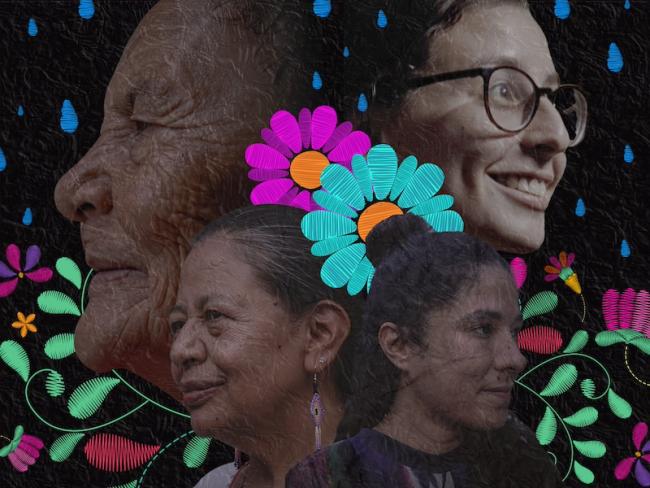
This article was originally published in Spanish by Kaja Negra. It is accompanied by a short documentary that can be viewed here.
One day in April 2023, the mate prepared with tap water in Montevideo began to taste like salt. A three-year drought left the river that supplies the Uruguayan capital with fresh water at a record low, and authorities remediated the problem by pumping in salt water for consumption. That day, the water crisis finally reached Montevideo, the southernmost capital of the American continent. In a country known for its high-quality water supply, half of the population could no longer drink tap water.
During the following month, thousands of protestors took to the streets to the chant of “no es sequía, es saqueo”: it’s not a drought, it’s pillage. They accompanied their shouts with the sound of the newly omnipresent plastic water jugs, hitting them against the ground in a percussive statement. Four months later, the supply returned to normal, but Uruguayans’ faith in their taps had evaporated.
At the other end of the continent, the residents of the Pedregal of Santo Domingo, a neighborhood in the south of Mexico City, have waged a long fight for potable water. Since Santo Domingo was founded in the early 1970s, residents supplied their homes with water from public taps and wells. To carry it, they used an aguantador, a yoke with a bucket on either side, which became a symbol of local identity. Half a century later, the neighbors discovered that a construction site was channeling a freshwater spring into the sewer, and they became pioneers in the fight for water in the Mexican capital.
As the climate crisis advances across Latin America, both struggles find women on the front lines, defending their communities’ access to water.
Mexico City, 1971
When Doña Fili, a tiny woman with deep wrinkles and smiling eyes, welcomes a guest into her home, she has the custom of giving them a stone from her altar. The assortment of volcanic rocks shares space with images of Emiliano Zapata, Monseñor Romero, and Victor Jara, all illuminated by a candle’s constant flame. The stones witnessed the creation of the neighborhood, the Pedregal of Santo Domingo, founded in 1971 as the largest urban land occupation in Latin America.
“The houses were so alike that you could go into another one as if it were your own,” Fili recalls. “We would say, all of us should have homes, even if they’re made out of metal sheets.”
In this area of stony, hostile soil, part of the Coyoacán demarcation, the neighbors organized to buy dynamite and open the streets. The men worked in factories, and the women cleaned homes in wealthy neighborhoods. On the weekends, everyone came together to build.
“Your hands ended up bloody from carrying dirt and rocks,” Fili remembers. “There wasn’t any electricity or water. We didn’t have anything, not even the government, except to try to throw us out. But if you didn’t have water, a boy brought you a full bucket and then you had water.”
With time and collective labor, the neighbors exchanged their metal walls for cement and the yoke for home connections to the city’s public water system. In 1997, the first leftist mayor of the capital, Cuauhtémoc Cárdenas, gave the inhabitants of Santo Domingo the titles to their houses.
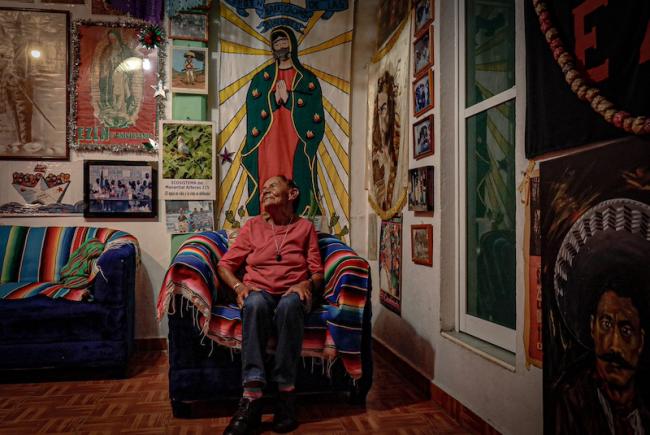
Montevideo, 2002
Holding up a glass of filtered tap water, Carmen Sosa exclaims, “Who could have imagined that I would use a filter? It used to be unthinkable!” The 69-year-old woman is an activist, union member, and former worker of the State Sanitary Works (OSE), Uruguay’s water supply company.
In 2002, Carmen and a group of other activists founded the still-existing National Commission in Defense of Water and Life (CNDAV). They fought for the amendment that includes access to potable water and sewage in the Uruguayan constitution as a fundamental human right.
On October 31, 2004, just as progressivism won the national government for the first time, 65 percent of Uruguayans voted in favor of the constitutional protection of the right to water, six years before the United Nations General Assembly recognized the right.
“They called us from all over the world to congratulate and interview us,” Carmen recalls. That’s why she never imagined this scene. “Many years ago, I told my daughters, you need to pay attention to this, because I won’t see it,” she reflects, “but one day you’ll open the tap and potable water won’t come out. And then, I saw it.”
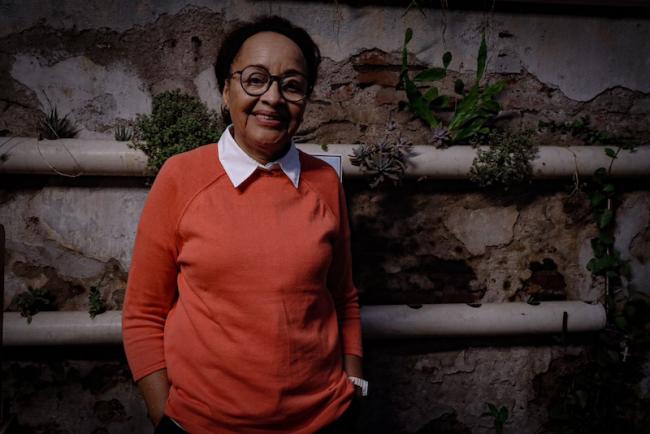
Mexico City, 2016
Decades after hauling water over the Pedregal’s unpaved roads, the neighbors once again came together to protect their shared resources. In 2015, they organized to denounce the “ecocide” committed by the real estate company Quiero Casa on Avenida Aztecas, one of the Pedregal of Santo Domingo’s main thoroughfares.
María Santiago Maqueda, an Indigenous woman from the state of Hidalgo who came to the Pedregal in late 1971, was part of the protest. “Mancera told us that the water was dirty, but Dr. Óscar Escolero from UNAM’s Institute of Geology demonstrated that it was clean, potable water,” María recalls.
Faced with the officials’ indifference, the people installed a tent in the street outside the construction workers’ entrance to the site. Neighbors sustained the protest with bean offerings and pots of coffee. On Fridays, they hosted the Stone and Spring People’s School, which received people from all over the country and Latin America in solidarity with Pedregal.
Doña Fili remembers it as a unique educational space for the community. “A protest camp transforms you. It transforms your thinking. Everything they’ve imposed on you to think changes. And that scares the system, the government, not just in Mexico, in the whole world, because people have the capacity to organize,” she says.
Canelones, Uruguay, 2016
In Melilla, rural Montevideo, Sofia Taranto juggles the activities that she organizes with her partner, Marcelo Cabrera, at the Charamusca free school that the couple founded in their home. Between preparing mate and vegetarian hamburgers, the 32-year-old with long, curly hair and a shy but friendly smile shares her reflections on social and environmental movements in Uruguay.
A descendent of the Charrúa nation and part of the Jaguar Berá community, Sofía was born and raised next in the agricultural region of Canelones, where most of the country’s food is produced, next to the Santa Lucía river, the same river that supplies Montevideans with water. As a teenager, Sofía invited friends from the neighborhood to clean up trash and plant trees on the riverbanks.“Water brings together all struggles,” Sofía says. “All extractive projects seek out water, and here they aren’t even charged for it, when the majority of the population is paying to consume water.”
In 2016, she led a signature campaign to ban soybean plantations—the same ones that have eroded the water quality of the Santa Lucía—in Canelones. Although the plantations have been banned in some of the departments, Sofia says that they continue to operate in the absence of regulation and enforcement.
Once she moved to Montevideo, she joined the committee of students fighting for land and water at the public university, where she studied psychology. In 2022, after the Covid-19 pandemic stifled the climate of social protest, she formed the Coordinadora por el Agua collective (Coordinator for Water), which the following year was key to articulating the street protests against the water crisis.
Sofía knows that the defense of water “did not begin with us, nor will it end with us.” Although sometimes she feels inclined to say “enough, everything is getting worse, I am not going to do anything else,” she always comes back to the same conclusion: “I cannot do nothing.”
Mexico City, 2024
Doña Fili's presence is not as ubiquitous as it used to be at protests in Mexico City, but taking her place is her daughter, María Elena López. Male, as friends call her, is a woman of sweet and firm words, with abundant hair that she pulls back to reveal her watermelon-shaped earrings that she crocheted in solidarity with the Palestinian people. Needle and thread have become a form of political struggle for Male and other women from the neighborhood, who founded the Yaocihuatl Pedregales embroidery collective during the Avenida Aztecas protest. After the parents of the 43 missing students from Ayotzinapa, the women of the Pedregales decided to embroider the portraits of the young people on cloths that went on to travel the world, most recently exhibited in Montevideo.
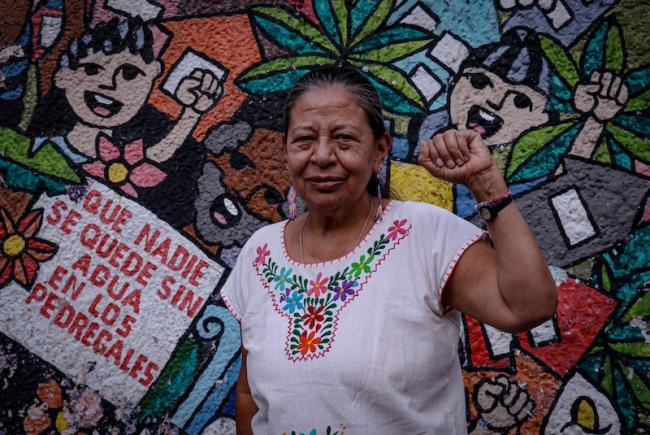
The collective is not the only offspring of the Aztecas 2015 sit-in. By the end of 2021, the Committee in Defense of Water succeeded in getting a new well, built to supply the Pedregal de Santo Domingo neighborhood. Despite facing political division, the Committee gathered more than a thousand signatures from neighbors demanding the construction of the well, one of the first to be built in the Mexican capital by popular demand.
“The neighborhood was founded 52 years ago, and we have been suffering from water for 52 years, because the authorities have always used it as political booty. They give it to us in drips to pressure people to vote for them,” explains María del Carmen Pelayo, a long-time resident and member of the Committee. "What we are trying to do is to get the people of the neighborhood to unite. We want to have a sense of community.”
Once the well in Santo Domingo began to operate, though, the supply began to fail. In March 2024, after some homes found their water cut off, the Committee warned the authorities that they would occupy the well if the issue was not resolved soon. It worked, and the water pressure returned.
Other neighbors in a nearby neighborhood in downtown Coyoacán have sought the Committee's guidance to receive their own well. “We are a little school of struggle,” says Male. She relates how “It’s not a working-class neighborhood, but it is amazing how with real social struggle, progress is made. Even though they requested the well, they haven’t gotten it, so they came to us and asked.”
Water management and scarcity became a central issue in the 2024 campaigns to govern Mexico City. Among the candidates' proposals was the creation of a social water comptroller. Beyond politicians' speeches, though, the Pedregal neighbors are a living example: they built a true form of community water management.
For the women of Santo Domingo, the defense of water is part of their responsibilities as caretakers. “We as women see the need we have in our homes,” María Santiago explains. “The man goes to work, but it is the woman who carries the heaviest burden: she has to cook, care for the children, see that they go to school, take care of the chores. If I don't have water, I’m not going to wait until my husband arrives to fetch it.”
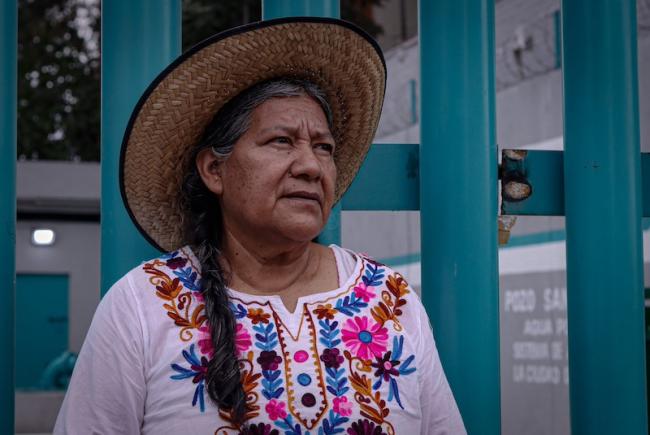
Montevideo, 2023-24
In Charamusca's kitchen, the whistle of the kettle signals that the water for the mate thermoses is ready. On an April afternoon in 2024, fifteen people gathered for the presentation of the Water and Territory Archive, a selection of posters, flyers, documents, maps, press releases, and research related to the socio-environmental movement in Uruguay.
During the presentation of the archive, different traditions of the struggle for water in the city converge.
Twenty-five-year-old Eliana del Río, a student looking to deepen her research on water conflicts in Uruguay, is the youngest participant. The drought put her, like thousands of others, on the streets.
The slogan “it's not drought, it's plunder” mobilized people like Eliana who had never before been involved in activism. They represent a new generation of environmentalists, and their spontaneous mobilizations gave them the name of the autoconvocades, the “self-convened.”
Every day in May 2023, they held assemblies and rallies in the streets. They used the drumbeat of the water jugs to make noise in front of the Ministry of Public Health, the Presidency of the Republic, the Legislative Palace, the OSE headquarters, and even the president’s home. Day after day, the protestors called attention to the water management system and its links with the production model.
During the four-month water emergency, water heaters broke due to high salinity, and people with hypertension, pregnant women, and children were warned to not drink from the tap. The Minister of the Environment, Robert Bouvier, stated on television that the water “is not potable, but it is drinkable and consumable.”
When the rapper Miel, born Elisa Monestier, drank salt water from the tap for the first time, she remembers feeling that the world as she knew it had changed forever.

“In Uruguay, we are taught in school that our greatest resource is water and that it is very good quality. They always told us that there was going to be a water war, and I imagined that it was going to be with tanks. But maybe the war is the people defending the water and the government persecuting the people,” she reflects.
During the four months of the official water emergency, Miel thought of all the people who could not pay for better water. “They said on national TV that this was because of the drought, while they gave millions of liters of water to international companies and told the people to buy it.”
She sees those mobilizations as a seed for the future: “No activism happens overnight. I found myself several times saying to my friends that I see myself marching when I’m 80 years old.”
Mexico-Uruguay, 2024 and beyond
Across the continent, the authorities have failed to respond to the structural causes of water crises. In Montevideo, water scarcity is a consequence of the model that prioritizes its use for the mass production of genetically modified monocultures, including soybeans. The authorities also recently approved the Neptuno-Arazatí project, a privately owned water treatment plant that will provide drinking water to Montevideo.
In Mexico, despite Claudia Sheinbaum—the first elected female president of the Republic—temporarily suspending work on the Aztecas construction site, the company eventually completed its apartment towers. Six years later, it continues to flush the spring water into the sewage system.
Despite the fact that political power continues to prioritize water for the use of capital, women organize to care for water just as they care for children and the elderly. From carrying the yoke through the streets of the Pedregal in Mexico City to banging drums in protest of salty water in Montevideo, women in cities protect natural resources as part of daily life.
Credits:
This project was supported by the 2024 ColaborAcción journalism grant from Fundación Gabo and Fundación Avina.
Text and reporting: Florencia Pagola, Carolina Bas Lemos, Madeleine Wattenbarger, Eliana Gilet
Photography: Lizbeth Hernández
Sound editing: Carolina Bas Lemos
Video recording and editing: Eliana Gilet
Text editing: Lizbeth Hernández and Florencia Pagola
Editorial support, the Gabo Foundation: Javier Drovetto
Graphic design: Paola Macedo

